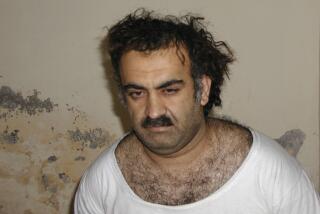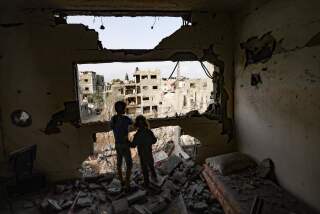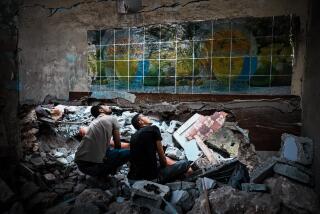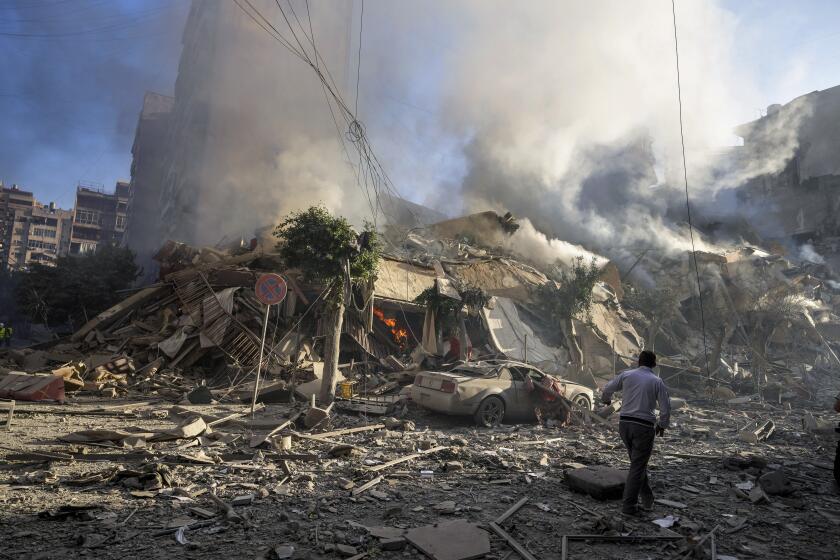Libyan rebel’s story shows links to Taliban, Al Qaeda, NATO
Reporting from Ajdabiya, Libya — He once lived under the Taliban’s protection, met with Osama bin Laden and helped found a group the U.S. has listed as a terrorist organization. He died in a secondhand U.S. military uniform, ambushed by Moammar Kadafi’s men as he cleared a road after an airstrike by his new NATO allies.
Aides to Abdul Monem Muktar Mohammed say the Libyan rebel fighter was leading a convoy of 200 cars west of this hotly contested strategic city Friday when a bullet struck him on the right side of the chest. He opened his passenger door and jumped out. A rocket-propelled grenade exploded nearby.
“Don’t wait, go,” he yelled to his men. Then he got to his feet, staggered a few steps and fell.
Mohammed’s final days were a mirror of his past, of a life that saw contradictions and intersections with U.S. policy, ones that could return to haunt the United States.
He arrived in Afghanistan in 1990 at the conclusion of the mujahedin’s silent partnership with the United States against the Soviet-backed Afghan regime. The following decades saw him become an international pariah, operating in an underground world of armed training camps and safe houses.
But with the revolt against Kadafi that started in February, he once again found himself in an uneasy alliance with the United States.
*
Five days before he died, with gray in his hair and bags under his eyes, Mohammed climbed a concrete tower on the outskirts of Ajdabiya and phoned in positions to the rebel government so NATO could drop bombs on Kadafi’s forces.
Putting down his Thuraya satellite phone, Mohammed waved a shiny black 9-millimeter pistol on a road filled with empty bullet casings and waited for the explosions.
A few hours later, Mohammed and his Omar Mukhtar brigade, one of the new military units officially sanctioned by the opposition government, rejoiced as blasts shook the city. A few started dancing and singing “God is great.”
“I have never been Al Qaeda now or in the future,” Mohammed said as he watched his men clap. “We are religious and ordinary people. We are Libyans fighting for Libya.”
The onetime holy warrior boasted that he even wanted a close battlefield relationship with NATO. But he also bristled at Western double standards. Why, he grumbled, does NATO so readily bomb the Taliban in Afghanistan but hesitates against Kadafi? Still, he would take any firepower he could get. He wished he had his own direct line to NATO rather than communicating through middlemen.
He laughed and said, “Give me their number.”
Rebel leaders are sensitive to criticism by some in the West that Al Qaeda “fellow travelers” are deeply involved in the fight against Kadafi. With some defensiveness, they say Afghan veterans such as Mohammed, 41, were pushed to extremes by Kadafi’s authoritarian rule, and that with freedom, the danger of a homegrown militant extremist threat has faded.
But there are many unanswered questions about Libya’s anti-Kadafi forces, with at least 20 former Islamic militant leaders in battlefield roles, according to the rebel army, and hundreds of Islamists participating or watching from the sidelines. All speak of unity and brotherhood, but in the new state, will they be tempted by a once-in-a-lifetime chance to overpower Libya with a conservative Islamist vision?
The fighters themselves might not even know their answer, caught up in the moment’s revolutionary fervor and vacillating between a longing for peace and their dreams of achieving an Islamic state.
*
Mohammed’s journey started at age 20, when he left his home in western Libya and traveled across the border to Algeria, flew to Frankfurt, Germany, then to Pakistan, and made his way with four Libyan friends to Afghanistan in early 1990. The year before, more than a 1,000 Islamists had been jailed in Libya, and Mohammed decided it was better to leave and try to follow a righteous path.
He fell in love with the mountains and the Afghans’ fighting prowess. With the fall of the old Soviet-backed Afghan regime in 1992, he and a group of other Libyan fighters decided to return home.
They slipped across the borders. The veteran mujahedin called themselves the Libyan Islamic Fighting Group, or LIFG, and vowed to kill Kadafi, declaring their ambition to form an Islamic state. Mohammed lived in the southern city of Sabha under an assumed name. He didn’t dare contact his family. He hated Kadafi for detaining hundreds of Islamists and remembered the yearly public executions of political detainees and students.
“Hitler was a good man compared to Kadafi,” he said.
A first assassination plot, in 1994, involved planting bombs at a celebration for Kadafi, but the explosives failed to go off. Two years later, he was involved in another botched plot when a man hurled a dud grenade at Kadafi. Mohammed acknowledged without a hint of embarrassment that he picked the bomber and the weapon.
Mohammed escaped, first to Tunis, the Tunisian capital, and then to Turkey. He married an Algerian woman; they set up a home in Istanbul and had their first child. But when a colleague was detained and handed by the Turkish authorities to Libya, Mohammed fooled them with a fake Tunisian passport and fled.
On the run, he learned that his family was paying the price for his failed plot against Kadafi. One of his brothers, whom he had met secretly for 30 minutes in 1996, had been jailed and would be locked up for eight years.
There was only one place for Mohammed to go: back to Afghanistan, under the protection of the Taliban. He spent time studying in military camp, and in classes on politics and Islam. About 100 members of the LIFG congregated in Kabul, the capital, longing for the day when they could kill Kadafi and rule Libya in accordance with Islam.
Here Mohammed would have his encounter with the two men who shaped the future of radical Islam: Bin Laden and his chief lieutenant, Ayman Zawahiri.
In 2000, he said, he met the two men twice, once at a funeral and another time at a guesthouse. They exchanged pleasantries and nothing more, he said. Bin Laden later sent an emissary requesting that the LIFG join Al Qaeda, but Mohammed said the Libyan group refused.
“Before 9/11, Bin Laden wasn’t infamous. Everyone had their own projects and people. He was a wealthy man. Our project was to kill Kadafi. They offered for our group to join, but we were focused on Libya.”
Mohammed remembered a brief meeting when the group debated whether to join Al Qaeda. He said they disagreed with Bin Laden’s theory that if the United States was weakened, its Arab allies would fall.
“We were concerned with Libya and nothing else. We didn’t believe in killing civilians or fighting the United States,” he told The Times on Tuesday.
But there are disputes about whether the group ever did, in fact, pledge allegiance to Al Qaeda. In November 2007, Zawahiri and a senior Libyan Al Qaeda member with close ties to the LIFG said the group was joining the terrorist network. The LIFG followed with a strong denial.
Mohammed insisted that the Libyan insurgents knew Bin Laden’s 9/11 attack was a disaster for them. He was sure Kadafi would use the assault on the U.S. to hunt them down and woo Washington to his effort.
“Sept. 11 caused a big problem for us,” he said. “We rejected Sept. 11. It hurt our group. Kadafi was so happy.”
Within two days, the Libyans sent their wives to Pakistan and followed soon after. Mohammed left for Pakistan and then sneaked across the border to Iran. But instead of giving him a warm welcome, the Iranians imprisoned him for 7 1/2 years. At the time, Iranians were suspected of detaining Al Qaeda members for use as bargaining chips with the Americans.
Other leaders were captured by the Americans in Thailand, he said, and then sent to Kadafi’s jails in Libya. After his release, he lived quietly in Iran. The humiliation caused his voice to rise. “Don’t ask me about this period,” he said.
When the Libyan revolt started in February, Mohammed came back almost immediately.
After arriving in Benghazi, the rebels’ stronghold, he met with heads of the rebel council and was made the leader of his own fighting brigade. The council issued him an ID badge proclaiming him “a general of the revolutionaries” and head of the Omar Muktar brigade, which he said had 150 members.
Members of Mohammed’s group, the LIFG, are scattered throughout the new volunteer army. Its leaders keep a low profile but met shortly after the uprising began to rename themselves the Islamic Movement for Change.
On a recent day, Mohammed sat in an empty villa in Ajdabiya, on a residential street decorated with a pink flower hedge. He had just come back from manning battle positions. Three fighters slept on a couch, cradling their rifles. He fiddled with his phone and wolfed down some boiled chicken and pasta.
He said that, when the fighting is done, he dreamed of returning to his birthplace and being left alone.
“I want to hand in my gun and be with my children,” he said. Then he walked to his olive-green pickup, followed by his men.
More to Read
Sign up for Essential California
The most important California stories and recommendations in your inbox every morning.
You may occasionally receive promotional content from the Los Angeles Times.










